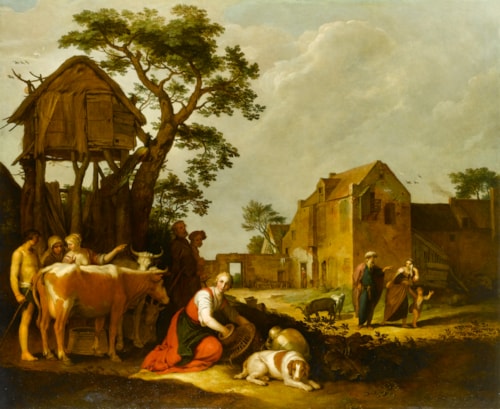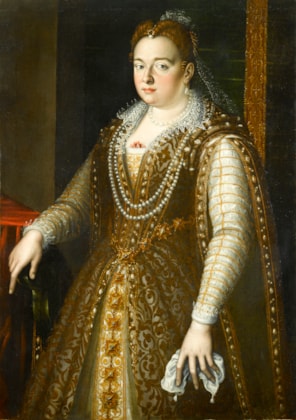an Josef Horemans the Younger
(Antwerp 1714 - Antwerp 1790)
The Concert
oil on canvas
69 x 59 cm (27¼ x 23½ in)
The Concert splendidly depicts an animated gathering of revellers outside a village inn. Taking centre stage is a dancing couple. The elegant lady gathers up her skirt, from which a dainty toe peeks out underneath, and her partner, more vigorous in his approach to the dance, gestures enthusiastically.
Two musicians accompany the dancers; one, seated with his back turned to the viewer, plays the double bass, while the other stands and plays the fiddle. At a table, an attractive young lady in a blue silk dress with white trim is seated. Her fine dress is accessorised with kid gloves, pearl earrings and a pearl necklace. She observes the dancing with interest as do her companions, a gentleman in brown, and a lady with pink rosettes in her hair and at her chest. Behind them, another lady inclines her head, deep in conversation with a man wearing a jaunty hat with ostrich plumes.
Although in a rural setting, the gathering is not the raucous mix of carousing villagers and peasants that one associates with Jan Josef Horemans the Younger’s Flemish artistic forbearers, Pieter Bruegel and Rubens. Instead, Horemans presents us with an elegant image of restrained gaiety. Perhaps this was partly influenced by the popularity of ‘conversation pieces’ in the eighteenth century, which were a form of group portrait set within an informal surrounding, often shown in conversation, or perhaps the painting may even be a take on the popular Fête Champêtre of the Rococo.
A perfect compliment to the present painting, which is concerned with dancing, is a painting by Horemans in the Hermitage devoted to singing. Here, a group of men and women are clustered around a table in a darkened interior. One plays a cello, while his companions sing, the two ladies dutifully holding their song books. They are a more serious group than in The Concert, and the table is set for tea rather than crowded with wine glasses. The setting for the gathering is a large and sombre room, indicating that the household is of considerable means and respectability.
The presence of the seated lady in the centre of the singing lesson is striking as she is identical in face, dress and pose to one of the ladies at the table in The Concert. Such an obvious repetition makes it interesting to speculate as to the lady’s identity; perhaps she was a relative or favoured model of the artist. In the Hermitage picture, she wears an enigmatic smile and her gaze is turned away from her companions and song book, towards the window. Perhaps she is distracted by a more lively party such as that depicted in The Concert outside.
Horemans was the son of Jan Josef Horemans the Elder. Like his father, he specialised in capturing the essence of the age he lived in, depicting social gatherings with spirited detail. His nickname ‘le Clair’ was used to distinguish him from his father and referred to his preference for a lighter palette. Although his speciality was in painting genre scenes for private patrons, often borrowing elements from the seventeenth-century experts David Teniers and Hieronymus Janssens, Horemans also painted interior decorations and accepted a number of official commissions.
The Concert splendidly depicts an animated gathering of revellers outside a village inn. Taking centre stage is a dancing couple. The elegant lady gathers up her skirt, from which a dainty toe peeks out underneath, and her partner, more vigorous in his approach to the dance, gestures enthusiastically.
Two musicians accompany the dancers; one, seated with his back turned to the viewer, plays the double bass, while the other stands and plays the fiddle. At a table, an attractive young lady in a blue silk dress with white trim is seated. Her fine dress is accessorised with kid gloves, pearl earrings and a pearl necklace. She observes the dancing with interest as do her companions, a gentleman in brown, and a lady with pink rosettes in her hair and at her chest. Behind them, another lady inclines her head, deep in conversation with a man wearing a jaunty hat with ostrich plumes.
Although in a rural setting, the gathering is not the raucous mix of carousing villagers and peasants that one associates with Jan Josef Horemans the Younger’s Flemish artistic forbearers, Pieter Bruegel and Rubens. Instead, Horemans presents us with an elegant image of restrained gaiety. Perhaps this was partly influenced by the popularity of ‘conversation pieces’ in the eighteenth century, which were a form of group portrait set within an informal surrounding, often shown in conversation, or perhaps the painting may even be a take on the popular Fête Champêtre of the Rococo.
A perfect compliment to the present painting, which is concerned with dancing, is a painting by Horemans in the Hermitage devoted to singing. Here, a group of men and women are clustered around a table in a darkened interior. One plays a cello, while his companions sing, the two ladies dutifully holding their song books. They are a more serious group than in The Concert, and the table is set for tea rather than crowded with wine glasses. The setting for the gathering is a large and sombre room, indicating that the household is of considerable means and respectability.
The presence of the seated lady in the centre of the singing lesson is striking as she is identical in face, dress and pose to one of the ladies at the table in The Concert. Such an obvious repetition makes it interesting to speculate as to the lady’s identity; perhaps she was a relative or favoured model of the artist. In the Hermitage picture, she wears an enigmatic smile and her gaze is turned away from her companions and song book, towards the window. Perhaps she is distracted by a more lively party such as that depicted in The Concert outside.
Horemans was the son of Jan Josef Horemans the Elder. Like his father, he specialised in capturing the essence of the age he lived in, depicting social gatherings with spirited detail. His nickname ‘le Clair’ was used to distinguish him from his father and referred to his preference for a lighter palette. Although his speciality was in painting genre scenes for private patrons, often borrowing elements from the seventeenth-century experts David Teniers and Hieronymus Janssens, Horemans also painted interior decorations and accepted a number of official commissions.





 contact
contact contact
contact +44 20 7313 8040
+44 20 7313 8040









